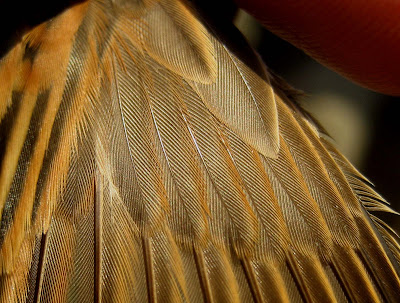We put up only 12 nets but caught better than predicted with 38 birds in about 4 hours before the wind got up, the sun warmed up and the birds dried up. 3 Chiffchaffs, 2 Reed Warblers and a single Blackcap were the only warblers and Reed Buntings were most numerous with 7. For anyone following the recent discussions on the ringers' forum, this was quite timely and it gave us a chance to scrutinise the various aging criteria for this tricky species.
Amongst the things we've looked at are:
- tail shape (usually narrower, more pointed and more abraded in young birds - though beware young birds that have moulted some or all of their tail)
- primary covert colour and shape (see below)
- primary tips (young birds more abraded and slightly paler)
- moult limits in young birds in tertials and alula
- eye colour (seemingly richer more orangey brown in adults and slightly colder brown in young birds - this is the most difficult though and we need to try using hand lenses and practise a lot!)
Below are some pictures of primary coverts which are perhaps one of the easier things to see. Adults (first two pics) have crisper, cleaner edges to the feathers with more rounded tips. The fringe is brown, but greyer at the tip. Note these were taken in rather different light conditions.

 Then those of young birds are more pointed with looser edges and there is little or no grey in the fringe.
Then those of young birds are more pointed with looser edges and there is little or no grey in the fringe. To make this difference even easier to see, I've zoomed in even closer for the next two pics so you can appreciate the individual barbs! Again, adult first, youngster second.
To make this difference even easier to see, I've zoomed in even closer for the next two pics so you can appreciate the individual barbs! Again, adult first, youngster second.
 Having said all that, we still caught a bird that was somewhere in between and we ended up aging it as a 2. As Richard de Feu said to me the other day - it's better to be accurately imprecise than precisely inaccurate.
Having said all that, we still caught a bird that was somewhere in between and we ended up aging it as a 2. As Richard de Feu said to me the other day - it's better to be accurately imprecise than precisely inaccurate.Insect numbers are dwindling, with the exception of hornets. We know it's a good site for these impressive beasts as we occasionally catch one or two in the nets. However, we caught 12 of the blighters today and it was as if there was some sort of convention. Fortunately for (some of) the hornets, we managed to remove about half of them safely. Fortunately for us we all remained unstung.
A single Red Admiral was the only butterfly noted. The water levels continue to plummet and we haven't had decent rain for weeks now.



No comments:
Post a Comment